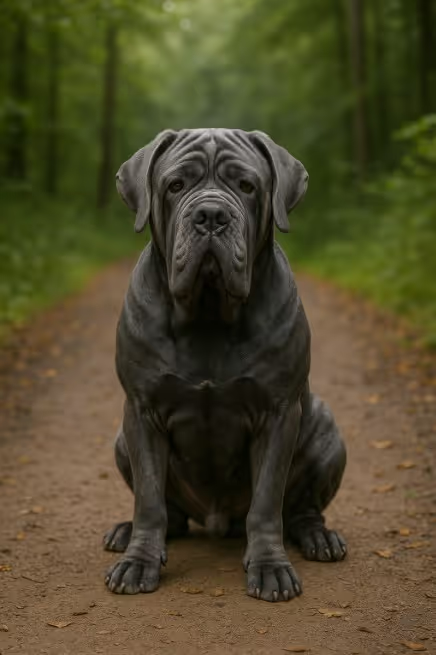The Neapolitan Mastiff is a massive, deeply wrinkled Italian guardian bred for deterrence, steady nerves, and family devotion. Calm, confident, and intensely loyal, the “Mastino” is naturally suspicious of strangers and best for experienced owners who can commit to early socialization, management, and daily structure. If you’re wondering “Are Neapolitan Mastiffs good family dogs?”—yes, in knowledgeable homes with clear rules. “Do Neapolitan Mastiffs drool?”—absolutely. “Do Neapolitan Mastiffs shed?”—light to moderate.

Rooted in ancient Roman war and estate dogs, the Neapolitan Mastiff was preserved in southern Italy—especially around Naples—as a farm and property guardian. Mid-20th-century fanciers, notably Piero Scanziani, organized and standardized the breed, emphasizing its hallmark loose skin, massive bone, and steady, defensive temperament. Today the Mastino is a recognized guardian breed worldwide, valued as a devoted family protector.
An enormous, rectangular Molosser with abundant loose skin and heavy wrinkles.
Low coat maintenance, high skin-fold care—and plan for drool.
Moderate needs; protect joints and avoid heat.
Intelligent, steady, and independent—calm leadership and consistency are key.
Feed for slow growth and joint health; keep them lean.
A powerful guardian with size- and type-related risks—screening is essential.
Temperament, health, and lifelong support matter—so do local bylaws.
Are Neapolitan Mastiffs good family dogs?
Yes—in experienced homes that prioritize early socialization, training, and supervision due to their size and guarding instinct.
Do Neapolitan Mastiffs drool a lot?
Yes—expect frequent drool, especially after drinking or exercise; keep towels handy.
Do Neapolitan Mastiffs shed?
Light to moderate; weekly brushing controls hair and dander.
How much exercise does a Neapolitan Mastiff need?
About 45–60 minutes daily of low-impact walks and training—avoid strenuous or repetitive pounding.
Are Neapolitan Mastiffs hypoallergenic?
No.
Neapolitan Mastiff vs Cane Corso—what’s different?
Mastinos are heavier-boned with loose skin and abundant wrinkles, bred primarily for stationary deterrence; Corsos are tighter-skinned, more versatile farm/estate guardians. Lines vary—meet breeders’ dogs.
How do I clean Mastino wrinkles safely?
Gently wipe and dry folds daily, especially after meals; use vet-approved drying solutions and monitor for redness/odour.
Are Neapolitan Mastiffs good apartment dogs?
Generally not ideal—possible only with strong management, training, and space planning for a giant dog.